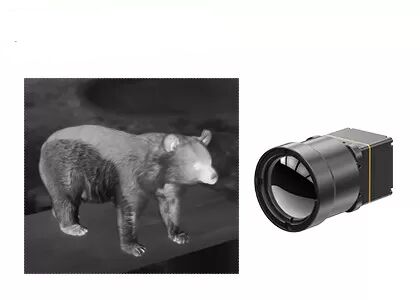-
Thermal Camera Core
-
Thermal Security Camera
-
Drone Thermal Camera
-
Plug-in Thermal Camera
-
Cooled Infrared Detectors
-
Cooled Camera Modules
-
Optical Gas Imaging
-
Infrared Thermal Camera Module
-
High Resolution Thermal Camera Module
-
Thermal Camera For Fever Detection
-
Vehicle Mounted Thermal Camera
-
Integrated Dewar Cooler Assembly
-
Uncooled Infrared Detectors
Compact LWIR Thermal Camera Module 640x512 12μm for Intelligent Hardware

Contact me for free samples and coupons.
Whatsapp:0086 18588475571
Wechat: 0086 18588475571
Skype: sales10@aixton.com
If you have any concern, we provide 24-hour online help.
x| Resolution | 640x512 | Power Consumption | 0.8W |
|---|---|---|---|
| Spectral Range | 8~14μm | Pixel Pitch | 12μm |
| NETD | <40mK | Frame Rate | 25Hz/30Hz |
| Highlight | Thermal Camera Module 12uM,640x512 LWIR Thermal Camera Module,Compact LWIR Camera Core |
||
LWIR Uncooled 640x512 12μm Thermal Imaging Module with 25mm Lens for Outdoors
TWIN612 thermal module is a new arrival product developed by SensorMicro. It integrates 640×512/12µm ceramic package uncooled infrared detector. With typical NETD<40mk, the TWIN612 thermal module could present clearer, sharper and more detailed image.
With temperature measurement range of -20℃~150℃/0~550℃, accuracy of ±2℃ or ±2% and frame rate up to 30Hz, the thermal module guarantees smooth thermal image and accurate temperature measurement.
The TWIN612 thermal module has the advantages of compact design, light weight structure and power consumption as low as 0.8w. With enhanced image algorithms and temperature measurement function, the TWIN612 thermal module presents more stable images and accurate temperature.
Ceramic packaging process is similar to metal packaging, which is a mature infrared detector packaging technology. Compared with metal packaging, the volume and weight of the packaged detector will be greatly reduced. Thus, the TWIN612 thermal module could be applied to industries that have strict requirements on size, weight and power consumption.
- Mini Size: 25.4mm×25.4mm×35mm
- Light Weight: 25g
- Typical NETD<40mk
- Sharp, Clear Thermal Imaging
- Typical Power Consumption as Low as 0.8W
| Model | TWIN612/R |
| IR Detector Performance | |
| Resolution | 640×512 |
| Pixel Size | 12μm |
| Spectral Range | 8~14μm |
| Typical NETD | <40mK |
| Image Processing | |
| Frame Rate | 25Hz/30Hz |
| Start-up Time | 6s |
| Analog Video | PAL/NTSC |
| Digital Video | YUV/BT.656/LVDS/USB2.0 |
| Image Display | 11 in Total (White Hot/Lava/Ironbow/Aqua/Hot Iron/Medical/Arctic/Rainbow1/Rainbow2/Red Hot/Black Hot) |
| Image Algorithm | NUC/3D/2D/DRC/EE |
| Electrical Specifications | |
| Standard External Interface | 50pin_HRS |
| Communication Interface | RS232/USB2.0 |
| Supply Voltage | 4~5.5V |
| Typical Power Consumption | 0.8W |
| Temperature Measurement | |
| Operating Temperature Range | -10℃~50℃ |
| Temperature Measurement Range | -20℃~150℃, 0℃~550℃ |
| Temperature Measurement Accuracy | Greater of ±2℃ or ±2% |
| SDK | Windows/Linux; Achieve Video Stream Analysis and Conversion from Gray to Temperature |
| Physical Characteristics | |
| Dimension (mm) | 25.4×25.4×35 (Without Lens) |
| Weight | 25g (Without Lens) |
| Environmental Adaptability | |
| Operating Temperature | -40℃~+70℃ |
| Storage Temperature | -45℃~+85℃ |
| Humidity | 5%~95%, non-condensing |
| Vibration | 5.35grms, 3 Axis |
| Shock | Half Sine Wave, 40g/11ms, 3 Axis, 6 Direction |
| Optics | |
| Optional Lens | Fixed Athermal: 13mm |
The TWIN612/R thermal imaging module is applied to the field of Thermography, Security Monitoring, UAV Payloads, Robots, Intelligent Hardware, ADAS, Firefighting & Rescue
![]()
1. Can thermal imaging cameras detect through glass?
You might be surprised to know that thermal imagers often fail to detect through glass.
From a physics point of view, it is difficult to explain the technical reasons for this problem, but its principle is very simple. Essentially, visible light passes through glass, but glass acts like a mirror for infrared wavelengths (which is why thermal imaging camera lenses are often made of germanium or zinc selenide rather than glass).
If you point the thermal imaging camera at a window, the screen won't show the image on the other side clearly, you'll most likely see a blur, and it's likely a blurry reflection of the lens you're holding.
But this is not absolute, some infrared frequencies can pass through glass, and certain types and configurations of glass allow different degrees of infrared light to pass through. For example, car windshields tend to yield better results than standard household glass.




